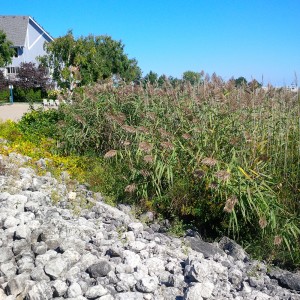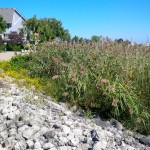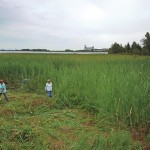Watch out for these other invasive plant species
stories by Marc Huminilowycz

Besides invasive Phragmites, the following invasive plants are considered to be the most threatening to water and land ecosystems in Southern Georgian Bay:
Giant Hogweed
A tall (2-4 m) herbaceous plant that looks similar to Queen Anne’s Lace and Cow Parsnip. Dangers: Shades out native plants; causes erosion of lakes, streams and wetlands; threatens salmon spawning sites. Also contains nasty toxins that cause severe burns when touched.
Dog Strangling Vine – A vine with pinkish-purple, star-shaped flowers grows by entangling other plants. Dangers: Can completely cover the forest floor, choking out other plants.
Himalayan Balsam
A tall herbaceous plant with a fleshy pink stem, distinctly jagged opposite leaves and irregular cone-shaped pink flower is found along stream banks. Dangers: Creates dense stands that prevent native plants from establishing, reducing biodiversity and ecological value of land; draws pollinators away from surrounding native species; produces about 800 seeds per plant, which are released from capsules once they are disturbed or dry out; aggressively replaces native perennial plants along river banks, leading to soil erosion.
Garlic Mustard
First-year plants have a rosette of dark green foliage and produce a strong garlic odour when crushed. Second-year plants have white flowers on a tall stalk. In mid-summer, narrow seed pods appear. Dangers: invades relatively undisturbed forests; displaces native wildflowers like trilliums and trout lily; hinders other plants by interfering with the growth of fungi that bring nutrients to the roots of the plants; threatens several of Ontario’s at-risk plant species, including American ginseng, drooping trillium, false rue-anemone, hoary mountain mint and white wood aster.
Wild Parsnip
From the same family as Giant Hogweed, but with yellow flowers and not as tall. Dangers: can form dense stands that outcompete native plants, reducing biodiversity; stem, leaves and flowers contain chemicals that can increase skin sensitivity to sunlight and cause severe dermatitis; reduces the quality and saleability of agricultural forage crops such as hay, oats, and alfalfa; chemical compounds in the plant are known to reduce weight gain and fertility in livestock that eat it. Do not touch! Sap can cause severe burns.
Japanese Knotweed
One of the hardest invasive plants to control due to its strong and aggressive root systems. Smooth, reddish-purple bamboo-like stems and small greenish-white flowers. Dangers: Spreads quickly, creating dense thickets that degrade wildlife habitats; reduces plant biodiversity by competing with other native vegetation; thick layers of decomposing stems and leaves on the ground make it difficult for native plant species to establish; aggressive plant with a strong root system that has been known to break through asphalt and concrete; can establish along riverbanks, where pieces of roots can break off and float downstream to start new populations.
Common Buckthorn
A small tree 5-6 metres tall with smooth, dark green finely-toothed leaves, thorns on the ends of branches, small yellow flower clusters and berry-like black fruit in late summer and fall. Dangers: thrives in a variety of habitats and forms dense thickets that crowd and shade out native plants; can alter nitrogen levels in the soil, creating better conditions for its own growth and discouraging the growth of native species; produces large numbers of seeds that germinate quickly and prevent the natural growth of native trees and shrubs; can host oat rust, a fungus that causes leaf and crown rust and affects the yield and quality of oats; the soybean aphid, an insect that damages soybean crops, can use buckthorn as a host plant to survive the winter. Because it can affect agricultural crops, common buckthorn is listed as a noxious weed under Ontario’s Weed Control Act.
For photos and full descriptions of these and other invasive species, visit Ontario’s Invading Species Awareness program website at invadingspecies.com.
An Invasive Species Guide, produced by the Nottawasaga Valley Conservation Authority in partnership with Georgian Bay Forever, the Blue Mountain Watershed Trust, Environment and Climate Change Canada, and the Town of Collingwood, is available on the Georgian Bay Forever website (georgianbayforever.org). In addition to the invasive plants listed above, the brochure describes non-herbivorous aquatic and land species threatening our region. ❧














